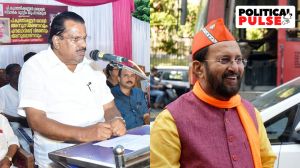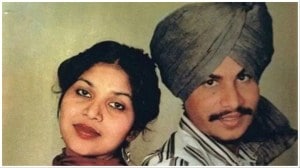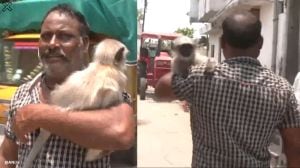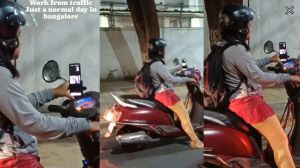- India
- International
At 11, Vaassangyaan Chaudhary is the world’s youngest to climb Stok Kangri peak
The world's youngest to climb 20,182-ft comes from a family of nature lovers and mountaineers.
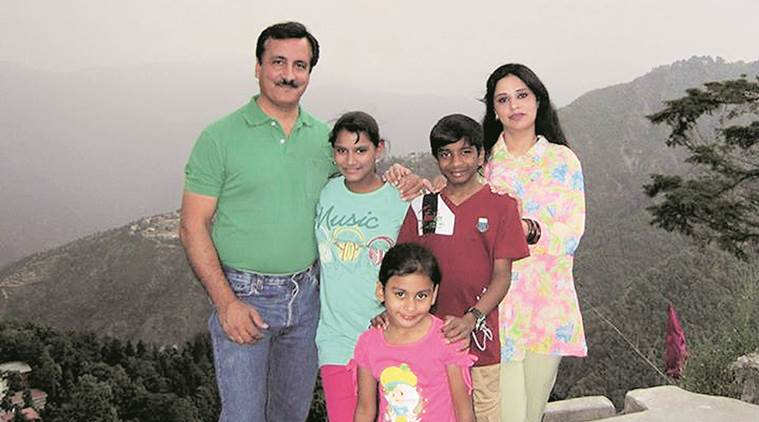 11-year-old Vaassangyaan Chaudhary (center left) is the youngest in the world to climb the 20,182-ft high peak of Stok Kangri (Express photo)
11-year-old Vaassangyaan Chaudhary (center left) is the youngest in the world to climb the 20,182-ft high peak of Stok Kangri (Express photo)
For boys his age, life is all about video games, food and studies. But the “passion” of 11-year-old Vaassangyaan Chaudhary from Baraut in Baghpat district took him to the peak of Stok Kangri, the 20,182-ft high mountain in Ladakh, making him the world’s youngest to do so.
But the son of environment-loving parents Sandeep and Manisha Chaudhary, management consultants by profession, is not the first in the family to have successfully battled “extreme weather conditions”.
Vaassangyaan’s younger sister, 10-year-old Manassangyini, has already trekked to the Kanchenjunga base camp at 16,300-ft and is the brand ambassador of the state government’s campaign to save west UP’s heavily polluted Hindon river under its Hindon River Rejuvenation Project.
The achievements keep getting higher and the age of achievers keeps dropping as you go through the family trail. The Chaudharys’ youngest, six-year-old Suryassangyini, made history in March this year by hoisting the tri-colour at the 16,300 ft high Kanchenjunga base camp.
[related-post]
Watch Video: What’s making news
The three are used to brave extreme weather conditions, low oxygen level and the dangers of mountains. For them, minus 18 degrees is “fun” and they never quit any assignment in between. In the last five years, the family has taken up several expeditions, including the 14,000 ft high Himani Chamunda in Dharmshala. Suryassangyini, when she was only two and a half years old, had trekked the 12,500 ft high Pindari glacier in 2011.

Their lessons, however, starts every day with their trip to school. From their home in Baghpat district, the three travel 25 kms every day to reach their Delhi Public School in Sonipat, Haryana, where, however, “they don’t benefit much”.
“The education system has become too theoretical these days,” says their father Sandeep. “Children will not learn the lessons of life unless they get the chance to go out and explore on their own. The aim to take little children to tough trekking trips is to teach them about the environment and inculcate in them the love for nature in them,” he said.
The young achiever, meanwhile, is sleeping off his days – “at least 12 hours a day” – after his tiring journey in the Himalayas.
“It was tough to breathe and fight knee-deep snow at minus 18 degrees. Last 500 meters of 75 degree steep gradient were the toughest as I had to use ice-axe and crampons to climb. I managed to reach the peek at 9.45 am on June 6,” said Vaassangyaan, who wants to join the army.
His previous attempt on the morning of June 4 was unsuccessful because of the “extremely low levels of oxygen” leaving him breathless. To make matters worse, Vaassangyaan realised the 5-kg two-piece snow boots were hurting him badly after walking deep in the snow for 10 hours. He had to retreat to the base camp with his Sherpa, Padam Limboo, “to recover and restrategise”.
Two days later, his mentors and guides were at it again, this time with “simple trekking shoes”. On June 8, when he returned to Leh, Indian Mountaineering Foundation director Sonam Wangyal, a Padma Shree and the first in the world to scale this summit in 1963, waited to felicitate “the world’s youngest to scale the summit”.
Apr 26: Latest News
- 01
- 02
- 03
- 04
- 05

















